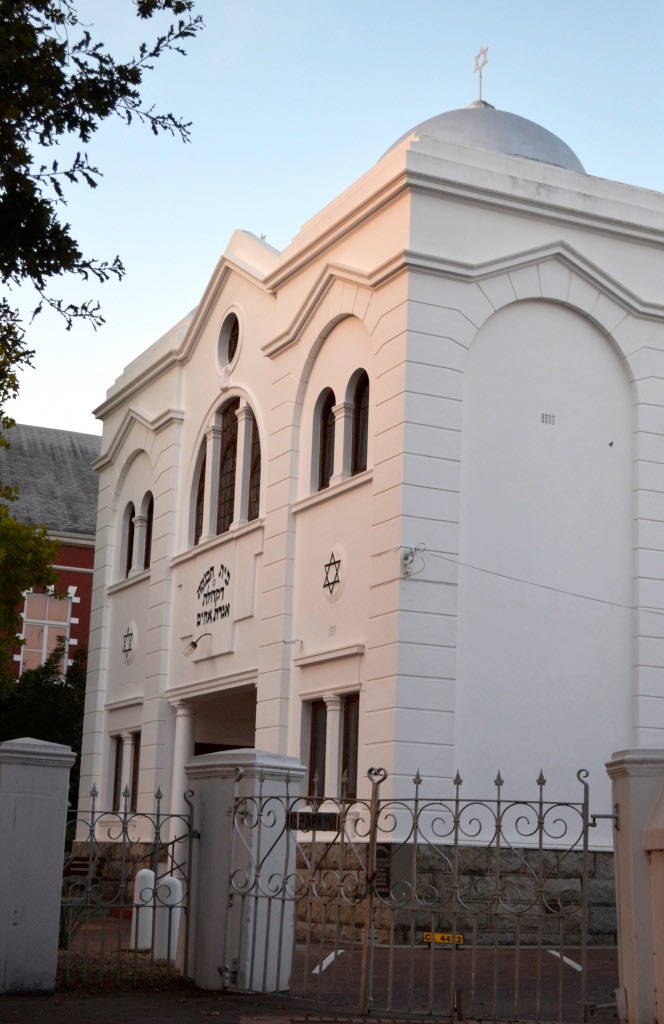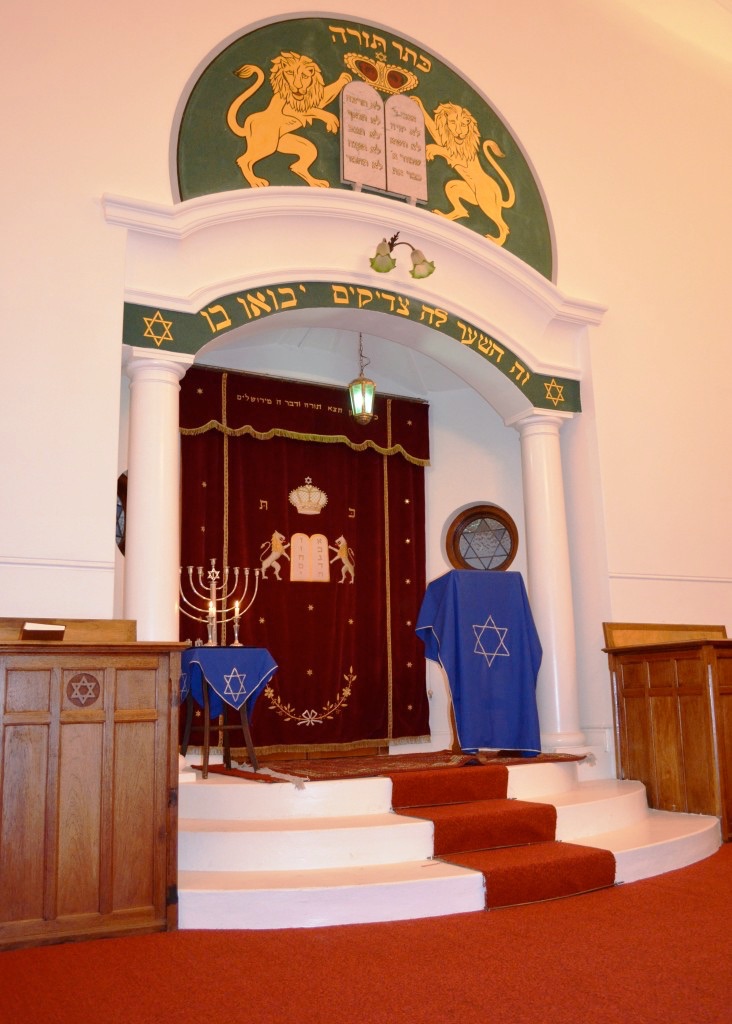Stellenbosch, South Africa

Stellenbosch University Journalism
Journalism – We breathe it!

Sabbath in Stellenbosch
Posted on April 29, 2012 by Erin Bates
Ryneveld Street is home to popular cafés, cutesy interior shops and Stellenbosch’s 89-year-old synagogue. Erin Bates observed Shabbat at the local shul.
There is a stash of salted cashews, wrapped-up chocolates and a bottle of The Famous Grouse at the Stellenbosch Synagogue. But this stash only appears after Sabbath on Friday night, once members of the Jewish community in Stellenbosch have attended the service.
Dr Sidney Rose is a retired vascular surgeon from Manchester, England. He lives in Somerset West but worships in Stellenbosch. Dr Rose’s back may hunch over a little, his eyes might not see things crystal clearly, but his humour is as sharp as the juice of a Jaffa orange. “This is the synagogue. This is where the Jews hang out,” he says with a dry chuckle.
And he is quite right – this is the Stellenbosch Synagogue, where a handful of Jews meet weekly for Shabbat. In Judaism, certain religious occasions may only take place if ten adults (usually men) are present. There can only be a service if there is minyan, a quorum of ten men.
It takes a while to reach the tally at the synagogue in Stellenbosch. “Eight,” counts Bernice Rosendorff. “That’s not enough.” She bends left and right, trying to get a better view of the door, trying to spot another congregant. Then, Dennis Zetler and his nephew Leslie arrive, bringing up the tally to ten.
Bernice and her husband, Dr Gerald (Gerry) Rosendorff, settled in Stellenbosch in 1956. “We are the only Jews living in Stellenbosch,” he explains. For years Dr Rosendorff practised medicine with two Jewish doctors. They kept rooms in Dorp Street, diagonally opposite todays’ Checkers.
Speaking of the congregation, Rosendorff is frank: “Well, it has just depleted, but we carry on, the few that are left.” Small though the community may be, festivals remain highlights in the religious calendar. “When there is a festival,” says Rosendorff, “people all rally round, and we have a service.”
The Rosendorffs open the synagogue at 18:30. “We should‘ve started at half-past-five, quarter-to-six this time of year,” admits Rosendorff, “but the farmers cannot get here before then.”
The rest of tonight’s congregants drive into town from afar. Dr Rose travels from Somerset West, as does Bokkie Markus. The Zetlers travel from farms around Stellenbosch, and Jonathan Sendzul from Franschhoek. Businessman Sendzul wears jeans, a black t-shirt and Converse All Stars. His clothes reflect the relaxed, colloquial feel of the service. Sendzul is accompanied by his youngest son, Adam. Father and son don matching satin yarmulkes (traditional head covers) in white, with blue and silver embroidery.
Upon entering the synagogue, Dennis Zetler unfurls a red velvet yarmulke. It is almost, to risk a cliché, the colour of ripe strawberries. He places on the crown of his head. Dennis’s father, Samuel Zetler, was the first strawberry grower in the area. According to the second volume of Kollenberg and Norwich’s Jewish Life in the South African Country Communities, Samuel Zetler began farming in 1922. Today, his sons run a number of shops and farms around Stellenbosch. The Zetlers are a vital part of the local Jewish community, and of the synagogue.
It is easy spotting farmers in the pews. These are strong men, with broad and sturdy shoulders. Their furrowed brows speak of long summer days spent under a heavy sun. “Tonight we have a chap who lived in Israel for many years,” says Dr Rosendorff of Hilton Phillips, a stocky man, with heavy features and olive skin. “He was born in South Africa, Cape Town, and he is very fluent in Hebrew, and he’s got a nice voice, and he will conduct the service, but he’s a farmer. He actually helps on one of the farms.”
During the week Phillips works with the Zetlers at Limberlost. On Friday he steps up to the bimah (raised platform) to lead the service. He places a tallit (prayer shawl) over his shoulders and sings the Sabbath to life. Before the chorus of a psalm his voice surges and the rest now join him in song.
Not long into the service there is the crisp crackle of a sweet wrapper. Zena Bloch from Somerset West is opening a Sparkles mint. She wrenches the sticky lozenge from its crinkling wrapper. “It’s awfully loud, isn’t it?” Bloch asks her neighbour, herself speaking loudly. Everyone seems to be making small talk to their neighbours. Meanwhile, Phillips continues with the service.
Phillips takes a sip of wine from a silver goblet. He (as the cantor) thanks the Almighty, who “creates the fruit of the vine”. Traditionally, at this point in the Kiddush, children under 13 go up to the bimah to have a sip of the wine. Adam Senzhul bounds up to the stand on cue. Phillips begins looking for a cup for Adam. “Just use the glass,” someone chirps in from the pews. And so the boy, with his blunt blonde fringe, is handed the goblet for a sit.
Adam sits adjacent to his father for the rest of the service. Next year he will follow in his brother’s footsteps. His Bar Mitzvah will take place towards the end of the year, perhaps near Hannukah. Probably in preparation for this rite of passage, Adam’s father hands him a hefty volume filled with prayers and readings from the Torah.
Although Adam represents a younger generation, the Jewish community in Stellenbosch may grow so small that it no longer makes minyan.
“[The synagogue] is going to close up eventually,” Dr Rosendorff sighs. “There’s nobody else that has the time, that can be in charge and look after things. So, when I retire someday, for some reason or other, I don’t know what’ll happen.”
After the service, everyone meets in a room to the right of the synagogue entrance. The room is so small the congregation seems double, triple its size. A bottle of The Famous Grouse appears, along with Schweppes lemonade, cashew nuts and chocolates wrapped in shining red, green, and gold paper.
“Here, because it is such a small community, the atmosphere is very nice and friendly,” says Bernice Rosendorff. “Everybody knows everybody; it’s like a big family.”
Dr Rosendorff adds, “We’re a minute community and we’ve got to stick together.”
Star of David- There were 23 Jewish families in Stellenbosch when the foundation stone was laid in 1923 by Rev A P Bender of Cape Town. The major of Stellenbosch, the Dutch Reformed Church minister and the magistrate attended the ceremony. Photo: ERIN BATES
Interior- Much of the woodwork in the synagogue was crafted by Sam Meyer. Austrian-born Meyer was a skilled cabinetmaker in Stellenbosch. In 1915 he settled in Stellenbosch, following his release from an alien camp in Pietermaritzburg. Meyer’s workshop produced furniture for Victoria College (later the University of Stellenbosch). Photo: ERIN BATES
Source: Kollenberg and Norwich’s Jewish Life in the South African Country Communities (2004).
With thanks to Erin Bates




